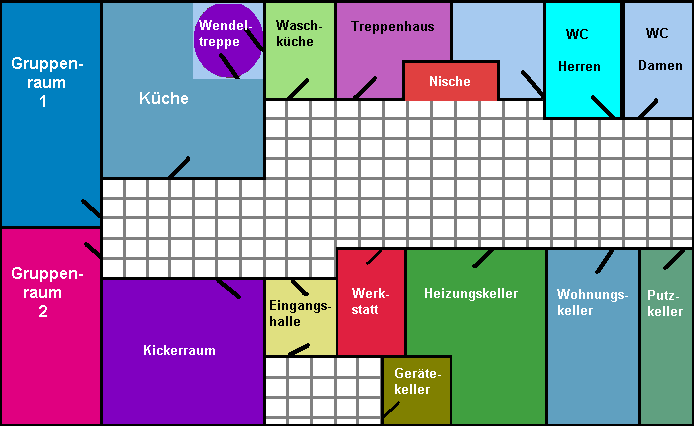source: www.youthwork-practice.com | 2000 Games, Devotions, Themes, Ideas and more for Youth Work
only for private using
Action-Memory
The following idea was tested and sent in by the FeG HH-Bahrenfeld boy’s brigade. Action-Memory is a mixture of Memory, Sagaland and Cluedo and can be played with 5-10 children. For the game you will need a normal Memory game, playing figures, a die and a map (area plan) of the playing area.
Area plan as a playing area
The plan of the area represents the playing board. On this plan of the area the layout of the cellar (for example) should be drawn and all of the rooms are drawn in. This layout must not be 100 % identical to the cellar but it should be recognisable as the cellar. Millimetre paper is suitable. The hallway or other connecting rooms should be filled out in little fields (1cm x 1cm – field on millimetre paper) where the playing figures are positioned. There should not be too many fields between the fields. Obviously the rooms on the layout can also be created like the original (carpet colour, furniture; cut from a catalogue). The plan should look like a Cluedo game board. Watch out: the preparation of the plan can take a lot of time!
Preparation
-
One room is chosen as a starting room. Memory cards are spread out in all other rooms.
-
Only one card of each pair of memory cards are spread out. The cards are placed openly in the room.
-
Make sure that you write down where which cards are placed.
-
The other cards are mixed well and placed in a pile in the start room.
-
The top card is uncovered.
-
The players should now find the room where the object is.
-
Each player receives a playing figure which is placed on the area plan in the start room.
Game rules
-
Once one of the players is chosen as the beginner, the dice is thrown. The player may move his playing figure along the board according to the score on the dice (little fields in the hallway). The player will generally leave the start room over the hallway.
-
If the player reaches another room he may look for this room “in real life” and take a look at the memory card in the room. If he doesn’t reach a room he tries again in the next round.
-
If the rooms do not need the complete dice score to reach them, the rest of the score is lost.
-
Some rooms can also be reached without dice by simply entering them through the neighbouring rooms if doors are available.
-
While one player is on the move the next player throws his dice.
-
If a player is not back before his go to throw the dice, then it is bad luck (does not happen very often).
-
Once a player has found the card he keeps quiet and only says it out loud when he has his next go. He is not allowed to throw the dice in this round. If he is right he receives the card. If not, it is the next players turn.
Aim of the game
The player with the most cards at the end of the game has won.
Extensions to the game
-
Make the area plan with secret passageways which connect two rooms. The passageways may be used instead of throwing the dice.
-
If the number 6 is thrown (or another number) mix the pile of cards instead of moving the playing figure along the board
-
Moves into the “hallway” may not be overtaken by other figures and / or not allowed to be moved diagonally.
Rooms:
Group room, kitchen, spiral stairs, wash room, stairway, wall alcove, gent’s toilet, recreation room, entrance hall, workshop, tool shed, boiler room, cellar room, stores.

[ © www.youthwork-practice.com | 2000 Games and Ideas for Youth Work ]






